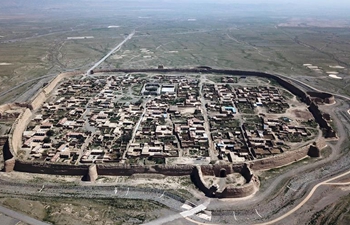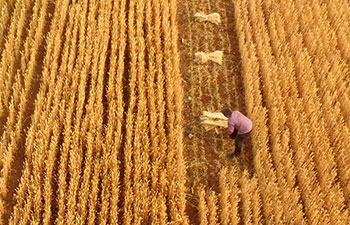WASHINGTON, May 29 (Xinhua) -- The U.S. National Weather Service (NWS) confirmed dangerous tornadoes in Kansas and Pennsylvania on Tuesday night, marking the 13th consecutive day of severe storms damaging large areas in the United States.
Similar threats on Wednesday will stretch from Texas all the way to the northeastern state of New Jersey, with tornado threats highest in the southern plains, said local media reports. More heavy rain could mean more flooding.
From the Central Plains into the mid-Atlantic, there were an average of 27.5 tornadoes occurring each day in the country in past 13 days, said the authorities.
One day after a massive destructive tornado hit midwestern state Ohio, another dangerous tornado touched down in Kansas on Tuesday, striking the southeast portion of Lawrence, according to the National Weather Service, urging caution for potential hail, strong winds and flash flooding as another round of storms moved into eastern Kansas and western Missouri.
While residents in Linwood, Kansas, 15 miles east of Lawrence, appeared to be safe, dozens of homes just outside city limits are "all gone," Linwood Mayor Brian Christenson told CNN in a phone interview, saying he saw roofs torn off of homes.
The storm debris closed the airfield at Kansas City International Airport, delaying flights, the airport said.
Tornado warnings were also issued late Tuesday evening for Staten Island in New York City as well as Newark and Elizabeth, New Jersey. In northern New Jersey late Tuesday, officials were responding to storm damage including widespread power outages, downed trees and at least one sighting of a possible tornado.
About 14,000 Jersey Central Power & Light customers were without power in the Morris and Sussex county areas, utility company spokesman Dave Newcomb said Tuesday night.
"There was a line of very severe thunderstorms that moved through the area," he said. "We are sending all available crews."
The harsh weather caused major delays in airports of the area. At Newark Liberty International Airport, average delays reached nearly three hours, local media reported.
Extreme weather warnings were also issued across the state of Pennsylvania on Tuesday, including tornado warnings for Scranton, Dunmore, Wilkes-Barre and the Poconos.
At least one person died and 12 others were injured late Monday night after a "large and dangerous" tornado devastated Dayton and nearby area in Ohio. Dayton, a large city in the state's southwest and the county seat of the Montgomery County, is currently under a boil-water advisory.
A twister touched down in Pendleton, about 35 miles from Indianapolis, on Monday evening. At least 75 homes were damaged there and in nearby Huntsville, said Madison County Emergency Management spokesman Todd Harmeson. No serious injuries were reported.
Intense rain in Kansas and northeast Oklahoma have strained aging dams and levees, and a reservoir in Oklahoma that drains a massive watershed hit record water levels, according to local media reports. The U.S. Army Corps of Engineers opened a large dam to control the river flow, which put Fort Smith, the second-largest city in Arkansas, in the path of record-breaking flooding expected to last all week.
James Elsner, an atmospheric scientist at Florida State University in Tallahassee, told the NBC News that on average, four to five tornadoes typically strike as part of a cluster. But he and his colleagues found that since 1950, the number of days with a cluster of at least 32 tornadoes has more than doubled, while smaller clusters have declined.
He said that the average number of tornadoes over the past nearly two weeks is double the long-term average of tornadoes per outbreak, though figuring out what is driving this uptick has been challenging.
So far in 2019, there have been 935 reported tornadoes across the country, up from an average of 743 tornadoes at this point in the year from 2005 to 2015, according to the NBC report, citing the National Oceanic and Atmospheric Administration and Victor Gensini, a climatologist at Northern Illinois University in DeKalb, Illinois.
"We're not 100 percent sure what's causing that," said Gensini. "There are theories that for any given outbreak, there's more instability or fuel available for storms, but it's really difficult to know."
Last year was a very quiet year for tornadoes, becoming the first year since modern record-keeping began in 1950 that there were no "violent" tornadoes in the United States, said the NBC report. Violent tornadoes are those with estimated wind speeds of 166 miles per hour or higher.
There are two main ingredients that help tornadoes form: atmospheric instability, typically from a buildup of moisture and heat in the atmosphere, and wind shear, which refers to changing wind speed and direction with height that lifts air up and contributes to the storm's violent rotation.













